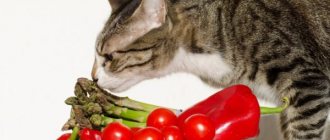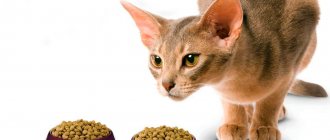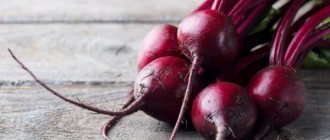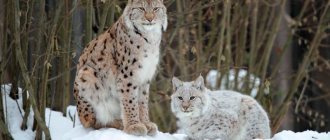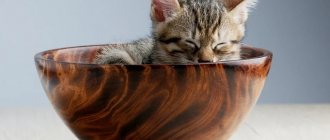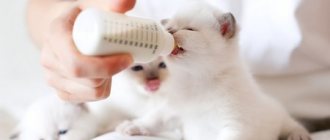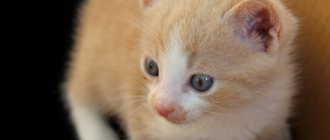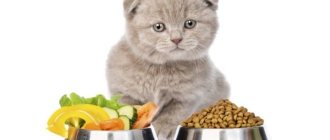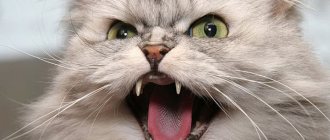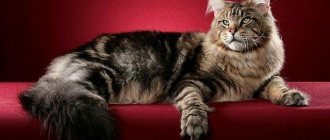Choosing nutrition plans at home
What to feed the pet - dry, canned food or natural products - the owner must choose for himself.
In any case, it is a good idea to seek advice from your veterinarian. Ready-made feed already contains everything necessary for the growth and development of the animal. When using them, there is no need to use additional vitamin-mineral complexes. No need to waste time preparing breakfast, lunch and dinner for your pet. This is an excellent choice for busy or lazy owners.
The owner must balance the diet of natural products himself.
It is necessary that the cats' menu include:
- Proteins should make up the bulk of your cat's diet. They are necessary for the normal functioning of the body. The amino acids that make up proteins cannot be produced independently in the animal’s body, and therefore must be supplied with food. Meat, fish, dairy products, eggs are the main sources of protein.
- Fats are especially necessary during the growth period. They are given to the cat in the form of sour cream and butter. Fats provide the animal with the necessary energy. With excess fat in cats, excess body weight occurs, the coat becomes dull, disheveled, and depegmentation of color may appear.
- Carbohydrates - in their pure form, are practically not digestible by the cat, but they contribute to the absorption of food. Cereals, flour products, and corn flakes are rich in carbohydrates.
Vitamins A, groups B, C, D, E:
- Vitamin A – promotes the growth of the animal, strengthens the immune system, has a beneficial effect on vision and coat quality. Vitamin A is found in egg yolk, liver, green vegetables, and fish oil. Excess vitamin A leads to diseases of the skeletal system.
- B vitamins (B1, B2, B6, B12) – the need for these vitamins in Siberian cats is very high. They are found in sprouted wheat grains, brewer's yeast, oatmeal, and liver. Vitamin B1 is very important in the diet, as it has an anti-neurotic effect. Its deficiency causes convulsions and vomiting.
- The cat receives vitamin C through the grass it eats to cleanse the stomach.
- Vitamin D is responsible for the proper formation of the skeleton. The cat receives it with butter, milk, and egg yolk. A pleasant way to get your dose of this vitamin is to bask in the sun.
- Vitamin E - takes part in the formation of muscle tissue, protects against certain infectious diseases. With insufficient amounts of this vitamin, the functioning of the nervous system is disrupted. Vitamin E is contained in liver, kidneys, egg yolk, and yeast.
Attention!
Raw egg whites block vitamin E. Therefore, eggs should only be given to your cat in boiled form.
What to give a cat on a natural diet
If the owner decides not to give the cat dry food, care must be taken to ensure that the food is natural. The basis of the diet should be animal proteins (up to 70%). They are complemented with cereals and vegetables. After three years of age, the amount of animal proteins should be reduced to half the total diet.
Siberian cats need taurine, an amino acid that improves digestion and helps eliminate toxins from the body. The diet of Siberians should consist of the following products:
- meat (it is forbidden to give pork);
- different types of offal;
- sea fish - flounder, mackerel (it is strictly forbidden to give river fish);
- eggs (it is allowed to give them once every 7 days);
- vegetables;
- cereals (except semolina);
- sour milk products;
- greens (it is useful to add sprouted grains).
Meat is healthy raw and cooked. It is recommended to separate it from bone and fatty tissue. The fish part is served exclusively boiled. Every day the cat should receive 2 tbsp. vegetable puree. It can be mixed with meat.
A cat eating natural food must be given vitamins and minerals. It is forbidden to feed the animal only meat. This increases the load on the liver. In order for the stomach to function properly, the diet must include fermented milk dishes - cottage cheese, fermented baked milk, sour cream. But it is not advisable to give whole milk, as it leads to severe stomach upset.
Description of the breed
The Siberian cat breed is the most adapted animal from the cat family for life in the harsh Russian conditions. The Russian Siberian cat is famous for its love of freedom and affection. These animals are outwardly an expression of chastity, but in reality they turn out to be excellent hunters. In addition, these pets are famous for their loyalty to their owner. The breed is well adapted to life in urban environments.
This animal has an excellent character and is capable of sincerely and selflessly loving its owner. There are many cases where representatives of this breed have repeatedly saved their owners in emergency situations.
What can you feed?
For active growth and a healthy lifestyle, cats benefit from various cereals. They are usually given in the form of porridges. Porridge can be cooked with both milk and water. Their presence in the animal’s diet promotes hair growth and renewal. In small quantities, you can give rye bread - a source of vitamin B. Lean meat, boiled fish, vegetable purees are the basic products when feeding a cat natural food.
You should not add salt to your food: it contributes to kidney disease.
Important!
You should not give your cat chocolate. It contains theobromine, a substance toxic to cats.
Ideal diet
An ideal diet should be balanced. If the cat does not eat certain foods, they can be replaced with others that are similar in the presence of beneficial substances.
Very often, adult animals develop intolerance to milk. In this case, instead of milk, you can give fermented milk products - kefir, sour cream, cottage cheese (but not curd mass or cheese curds).
Color
Siberian cats come in all color combinations. Some of the colors were originally present in the breed, while others are the product of the painstaking work of many breeders. The total number of colors of this breed has exceeded 200, but not all of them have received general recognition. However, the cat has every right to participate in all elite competitions dedicated to the best breeds of cats with unusual colors.
In Russia, the most common color of the Siberian cat is black brindle. But you can easily find white Siberian cats, gray, orange, blue and many other color shades. The breed can have a variety of color patterns on its coat. Sometimes these patterns may have white markings and be pointed like a Siamese cat. Also, the Siberian blue cat is deservedly considered one of the most popular colors of the breed. Due to the popularity of the animal, it is often considered a separate breed. It is especially popular abroad.
The eyes of an animal are the pride of the breed. They can be green, gold or any other shade. Some representatives have eyes of different colors, usually large and round in shape.
How to properly create a menu from natural products?
A diet of natural products should include:
- Meat – the animal’s diet requires the presence of lean meats. Meat can be given both raw and boiled. About 70-100 grams per day is the norm for an adult cat.
- Fish, contrary to popular belief, is not a healthy food for cats. Raw fish contains thyminase, an enzyme that destroys vitamin B1. Occasionally you can pamper your pet with boiled fish.
- Cereals are an essential product for proper nutrition. Cereals can be given in the form of porridges, which can be cooked in either milk or water. You can add meat, vegetables to porridge or serve it in its pure form.
- Eggs are given to Siberian cats only boiled. The yolk, a source of vitamins, must be included in the menu. Crude protein contains a substance that destroys vitamin E and H, which can lead to hair loss and dermatitis.
- By-products - liver - are a source of vitamins A, H, group B, it should be given to animals once every two weeks. Raw liver can cause indigestion, while boiled liver, on the contrary, can cause constipation. Cats love this product.
- Heart - must be given after removing fat.
- Light - cats really like it, but the product is low in calories and contains a small amount of nutrients.
- Greens – cats eat them to cleanse their stomach. Sprouted wheat and oat grains are a source of vitamin C.
- Vegetables – for an adult animal, the norm for boiled vegetables is 2 teaspoons per day. Vegetables are given in the form of puree with added butter.
- Dairy products contain calcium, protein, and microelements. In adult animals, lactase intolerance often occurs, and therefore milk can be replaced with dairy products - kefir, cheese, sour cream, cottage cheese (but not cheesecakes and curd mass)
Features of feeding a cat
This breed has very developed habits and habits of a predator. A cat living at home cannot catch a mouse or a bird. And the animal’s protein needs remain high, no matter where it lives. Therefore, it depends on the owner how much valuable nutrients the pet will receive.
It is not allowed to give the cat table scraps. If you give her sausages, fried and smoked foods, she will develop metabolic disorders. There are a number of specific rules for feeding Siberian cats:
- Feeding should occur at the same time . An adult cat is given food 2 times a day. You should not give your pet large portions of food, as it will develop obesity.
- Food must be given so that the animal feels full . It is forbidden to feed your pet.
- The bowl where the food is located must be clean.
- There must be constant access to clean water . If the animal is reluctant to drink water, it needs to be given liquid food.
- You should also ensure that the diet is varied . Prolonged feeding of the same food will lead to diseases of the urinary and excretory systems, pancreas and liver.
Grooming
Although the coat is quite long and thick, it is easy to care for because it hardly tangles. Twice a week you need to brush your cat using a massage brush and comb. Siberians shed in spring and autumn; at these times of the year it is necessary to pay special attention to grooming. Be careful, not every cat will take this calmly.
For combing you need:
- wide flat brush;
- a brush with bristle hairs, preferably with a metal base;
- a metal comb with two different types of teeth: rarer and more frequent;
- a comb with rotating metal teeth.
You will also need: a special powder for wool, an aerosol conditioner for restoring wool after shedding, and a product that prevents the formation of tangles; shampoos of different spectrum of action - moisturizing, healing, restoring (if required). All of the above care items can be purchased at pet salons in your city. In order to comb the fur, you need to sprinkle it, work with a scraper and only then carefully run a metal comb with wide teeth several times through the wool in the direction of the growth of the guard hair. You can use a special glove to comb the wool. The owner needs to learn how to properly hold the pet while combing. The best option is to hold her in one place by the withers with your own hand. If necessary, grab the animal by the folds of the neck, without pain.
What dry food should you pamper your pet with?
Dry food is very convenient to use. By using it, you can be sure that your cat’s diet is complete. However, premium food is expensive.
It is better to choose food from well-known manufacturers. Now almost all of them produce food for long-haired animals. Sterilized animals need specialized feed containing substances that prevent the occurrence of urolithiasis.
- ROYAL CANIN.
- HILLS SCIENCE PLAN.
- PURINA PROPLAN.
These brands can be purchased at pet stores at an affordable price. The range of food produced by these manufacturers is quite wide.
Important!
If you decide to feed your cat dry food, then you need to ensure that drinking water is available in direct access at all times.
Major diseases and nutrition
Siberians can be proud of their good health. They do not have certain genetic diseases. However, living with a person left its mark - Siberian cats began to overeat.
Recently, they often suffer from obesity. In this case, it is necessary to transfer the pet to proper and dietary nutrition. Remember that an adult animal should eat no more than 200 g of food per day.
Like all other animals, Siberian cats are susceptible to dental diseases. Therefore, the diet should always include dry food, which prevents the formation of tartar. An excellent option is Royal Canin ORAL Sensitive 30.
Siberians can also suffer from parasitic diseases. They are most often observed if the cat is completely on a natural diet. Here you need to consult a veterinarian and switch to a mixed diet.
Review of good ready-made food for Siberian cats
If the owners plan to feed their pet with ready-made food, then they should learn a simple rule: there is no need to skimp on food. And even more so, it is forbidden to buy the animal the cheapest food sold in supermarkets or markets. They can cause severe liver disease and urolithiasis.
Let's consider which balanced commercial diets are suitable for cats of this breed.
Orijen Regional Red
This is food from the holistic class. Fresh natural raw materials are used in its production. The diet includes fresh meat, devoid of bones. The rest is legumes, vegetables and other natural ingredients. Orijen Regional Red has an excellent taste, thanks to which pets enjoy consuming it.
According to cat owners, after this food, their pets’ fur becomes very beautiful, fluffy, and shiny. Thanks to proper nutrition, it is possible to prevent shedding.
Grandorf Rabbit Rice Recipe
This food is classified as a super-premium product. It is specially designed for sterilized animals and those individuals who have high sensitivity of the digestive tract.
Grandorf Rabbit Rice Recipe contains fresh meat. Vitamin supplements improve the structure of the coat, the cat is agile and playful. Long-term feeding can help remove bad breath.
Acana Grasslands Cat Kitten All Breeds Lamb
This is a worldwide brand of cat food made in Canada. The diet contains high-quality meat, plant ingredients, minerals and vitamins. Does not contain grain additives or allergens. Acana Grasslands Cat Kitten All Breeds Lamb pellets are excellent for feeding kittens.
The product is quite nutritious, so 50 g of food is enough for one feeding.
Bosch Sanabelle No-grain
This German natural food does not contain synthetic additives or substitutes. Has a sufficient protein to fiber ratio. The food is perfectly digestible and has an excellent taste. It contains flax seeds, fish oil and eggs.
The Bosch Sanabelle No-grain product helps normalize digestion processes.
Iams Pro Active Health Adult Hairball
This is premium food. It is specially designed to combat the accumulation of hair in the digestive tract. The food is ideal for long-haired breeds.
Iams Pro Active Health Adult Hairball products contain high-quality meat without bioadditives, fish oil, vitamins, and taurine. Contains corn flour.
How to feed a Siberian kitten
Let's now discuss how to feed Siberian cat kittens. It is better to keep a little Siberian up to 2 months next to his mother. The best food for babies is mother's milk. From this age you can start the first complementary foods. First, try dry food soaked in water. Feed pellets should be small. From 3 months you can offer wet food.
Important! An adult cat's preferences depend on what it ate when it was young. If you feed your kitten only one food, he will probably grow up to be picky.
A Siberian cat kitten should be fed 6 times a day. As you get older, the number of meals you eat decreases. The following foods are ideal for babies:
- Orijen Cat & Kitten;
- Acana Wild Prairie Cat & Kitten All Breeds Chicken;
- Iams ProActive Health Kitten & Junior.
Miscellaneous
Siberian cats allowed to roam outside are prone to minor injuries to their paw pads caused by exposure to sharp objects or hypothermia. Baby cream will help you - after cleaning the paw pads from dirt, gently rub it into the skin.
Caring for the teeth of a Siberian cat will also require special attention. Since regular tooth brushing is difficult to achieve, prevention is important. By choosing food and monitoring its variety, you can avoid tartar and gum inflammation. A Siberian cat must receive a variety of food, including vegetables, cereals and even fruits.
Normally, a Siberian cat does not need to have its nails filed or trimmed. The exception is cases when she was forced to be immobile for a long time, cannot take care of herself due to old age, etc.
Diseases that develop due to poor nutrition
Due to improper and unbalanced feeding, Siberian cats may develop:
- Gastritis . Occurs due to the cat eating spoiled, low-quality food. The disease develops if you feed your pet food that is too cold or too hot. Animals develop diarrhea, vomiting and an unpleasant odor from the mouth. Animals may moan when walking.
- Stomach ulcers develop due to the predominance of too rough foods in the diet . Animals vomit blood. Characterized by lack of appetite and exhaustion.
- Tartar . This disease develops mainly in old Siberians. The stone causes inflammation of the oral cavity, accompanied by pain.
- Caries . Due to tooth decay, the animal feels very severe pain, due to which it loses its appetite.
- Allergies occur due to low-quality prepared food . The animal develops sneezing, coughing and watery eyes, hair comes out, and bald patches and rashes appear on the skin.
- Urolithiasis develops as a result of insufficient drinking regimen and eating low-quality food . The disease is manifested by urination disorders: the cat strains on the tray, becomes restless and meows pitifully. Blockage of the urethra leads to complete cessation of urination. If you do not help the animal, its kidneys fail, which is why it dies from poisoning by decay products.
- Due to improper feeding and obesity, the animal may develop diabetes . The cat is constantly hungry and thirsty. A laboratory test of urine reveals glucose in it.
Proper and balanced nutrition is the basis for the health and longevity of the Siberian cat. It is best to give the animal high-quality ready-made premium food. They provide the body with a full range of nutrients. You cannot feed a cat human food, as this has a detrimental effect on its health.
Source
Kitten nutrition: what do they eat?
Ideally, kittens should remain near their mother for up to two months. But if the owner, for some reason, decides to feed the little fluffy himself, then he should know that in the first weeks of life it is permissible to feed only a cat's milk substitute.
First 2 months
For the first two weeks of life, feeding occurs every two hours. In the third week - every three hours. Fourth week - every four. Starting from the fifth week, milk replacer can be alternated with cereals.
By the end of the first month of life, you can include meat in the kitten’s diet, which must be finely chopped. You can start adding vegetables and a few drops of oil to the porridge. Food should be at room temperature. By two months, the baby's diet should be quite varied.
From 2 to 4 months
From two to four months, new products are introduced gradually. It is important to especially carefully monitor the balance of your diet, since right now the most active growth is taking place. We must remember that kittens need proteins, calcium, and vitamins. It is also necessary to ensure that there are no harmful products in the baby’s food basket.
What not to give
The cat is strictly forbidden to give scraps from the human table and spoiled food. Her diet should not include:
- pickles;
- marinades and smoked meats;
- sweet;
- pork (despite the fact that it has a lot of protein, it contains fat);
- milk (cats tolerate this product less and less with age);
- liver (raw can cause flatulence, and boiled can cause constipation);
- boiled potatoes (this is a completely useless food, since the animal’s stomach does not digest starch);
- legumes (they are not only not absorbed by the body, but also lead to excessive flatulence);
- raw river fish (it leads to infection with worms);
- some vegetables - onions, garlic and tomatoes;
- grapes and raisins (these products, for unknown reasons, are extremely dangerous for cat health);
- nuts (they contain a large amount of phosphorus, which is harmful to the body);
- dog food (it differs in its composition, and its consumption leads to dystrophy);
- mushrooms
Milk should only be given to kittens. As the kitten gets older, they are gradually weaned off this product as their body stops producing lactose. Sometimes this product provokes an attack of diarrhea in the animal.
Contrary to popular belief, wild cats do not eat fish because they cannot catch them. And this product is not very useful for a four-legged friend. Frequent feeding of fish leads to the development of urolithiasis and hypovitaminosis K. Raw river fish is unacceptable because it is a source of helminths.
Sweets are prohibited because they lead to the development of diabetes and severe poisoning of the body. Chocolate is especially dangerous for cats.
Upbringing
It is best to start raising a Siberian cat from an early age, while she is a kitten. It’s best to start introducing an animal to a human home from the toilet. As a rule, a young pet should already be litter box trained. The Siberian cat kitten is playful and naughty, so it should be raised at a very early age.
In communicating and raising animals you need to know some rules:
- Firstly, it is strictly not recommended to hit or yell at your pet. As a last resort, it is better to simply explain to him what he did wrong. You need to accustom your Siberian to short but understandable words. But you shouldn’t forbid the cat absolutely everything, otherwise he will stop understanding commands.
- You need to accustom your cat to which places he is not allowed to be and which ones he is allowed to be in. Often, many owners allow their pets to sleep on the bed, climb onto the kitchen table, and hang on curtains and drapes. If you allow an animal to violate this prohibition, then subsequent education will be meaningless.
- From time to time it is necessary to pay attention to your pet, pet it, scratch its fur and paws, and play with it. This way you can protect the furniture in your home from cat scratches. In order to avoid damage to the plants, it is necessary to plant a little mint or cat grass along with the flowers.
- When feeding your pet, it is important to wean him from asking for food from the kitchen table. For this animal, it is better to feed it in advance and distract it with some kind of game. Only then should you sit down at the table yourself.
- The most important thing in raising any pet is patience. Under no circumstances should you use any type of aggression towards the animal; you need to communicate with the cat as gently as possible. Then he will better understand his master's intentions and respond with his devotion.
Where are you from?
The breed was bred in Russia simultaneously with the formation of the felinological movement in the country. There is a version that their ancestors were residents of the Siberian taiga, which is why cats have an appearance that helps them survive in harsh conditions. Work on the description of the breed was carried out from 1986 to 1989.
At first they were classified as Norwegian forest dogs, but over time the standards and characteristics of this particular breed were described. The name “Moscow Semi-Longhair” was proposed for her, but in the end the more historical name “Siberian” was chosen.
Did you know? The first mentions of cats, similar in description to “Siberians,” were found back in the 17th century. Then they were called Bukhara.
The breed was registered in the Soviet Felinological Federation in 1989, and in 1995 the breed standard was adopted and published by the World Cat Organization.
Features of mating and breeding
The Siberian cat is ready for the first mating at 7–10 months. By the time of mating, the animal must be dewormed. After mating, the cat owner needs to take care of the maximum care for the animal during pregnancy. During this period, the cat experiences drowsiness, increased appetite, and may even develop toxicosis.
If breeding offspring is not planned, then it is better to sterilize (castrate) the animal.
Contrary to popular belief, castration and sterilization are performed on both male and female cats. Only after sterilization does the animal not lose its sexual instincts and retains all organs related to the reproductive system. Females have their fallopian tubes tied, and males have their testes, as a result of which they cannot produce offspring. Castration involves the complete removal of the genital organs, so that the corresponding instincts in the animal fade away. Naturally, there is also no question of offspring.
For cats and cats, surgery is performed when they reach puberty, at approximately 7 months.
Breeding purebred kittens requires a lot of labor. Decent living conditions must be created for animals, and mating must be carried out only within the breed. In practice, it is difficult to maintain a breeding line within one cattery, so for existing cats, breeders select a pair externally.
Siberian cats take excellent care of their offspring, usually doing this in pairs
It is best to look for a purebred cat for mating at exhibitions, where you can see the existing offspring and get acquainted with the documents and pedigree of the animal. When breeding, breeders may encounter some discrepancies in breed characteristics. This is not considered a marriage. We are talking about intra-breed differences that animals have depending on the territory of their residence. For example, the distinctive features of Siberian cats of Sevastopol are thin and not too long hair, a wide nose and a massive head. To avoid the birth of kittens with obvious violations of standards, they try to exclude from breeding kittens that have defects in the breed.
Mixed nutrition
There are quite a lot of experts who argue that it is prohibited to use different types of feeding at the same time - artificial and natural, explaining this by the fact that such a mixture often leads to disorders of the digestive system and hypervitaminosis. Other experts believe that this is how cats should ideally be fed at two months of age. That is, if the balance is maintained, the animal will simultaneously eat natural food and receive all the important microelements from ready-made feed.
As for the dosage of feed for mixed feeding, it is necessary to consult a specialist. As a rule, the dosage largely depends on the baby’s breed, condition, weight and other parameters. It happens that sometimes overly caring owners begin to change the diet two weeks after two months. You shouldn't do this, it remains the same.
Character
The Siberian cat has a calm and friendly character, which makes the cat a good companion. Representatives of this breed are very sociable and become strongly attached to their owner. This feature has its pros and cons:
- If you are unable to provide your cat with the attention it deserves, your pet will be bored.
- On the other hand, a cat can become your most faithful friend who will accompany you for the rest of its life.
Siberians are often compared to a dog: the cat is distrustful of strangers, can defend its territory, and is wary of loud extraneous sounds.
The Siberian cat perceives other animals in the apartment as competition. He shows calmness and patience towards children, loves to play pranks and play with them.
The breed is distinguished by a sharp mind; they are smart enough to quickly perceive new information. Thanks to this, cats easily learn the rules of a new home.
